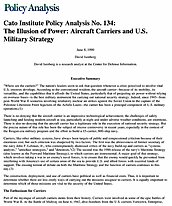“Where are the carriers?” The nation’s leaders seem to ask that question whenever a crisis perceived to involve vital U.S. interests develops. According to the conventional wisdom, the aircraft carrier–because of its mobility, its versatility, and the capabilities that it affords the United States, particularly that of projecting air power without relying on overseas bases–is the best military instrument for carrying out national security strategy. Indeed, since 1945–from post-World War II scenarios involving retaliatory nuclear air strikes against the Soviet Union to the capture of the Palestine Liberation Front hijackers of the Achille Lauro–the carrier has been a principal component of U.S. military operations.(1)
There is no denying that the aircraft carrier is an impressive technological achievement; the challenges of safely launching and landing modern aircraft at sea, particularly at night and under adverse weather conditions, are enormous. There is also no denying that the aircraft carrier has a legitimate role in the execution of national security strategy. But the precise nature of that role has been the subject of intense controversy in recent years, especially in the context of the Reagan-era military program and the effort to build a 15-carrier, 600-ship navy.
Carriers, like other military systems, have always been targets of public and congressional criticism because of their enormous cost, but such criticism was sharpened by two factors. The first was the abrasiveness of former secretary of the navy John F. Lehman, Jr., who contemptuously dismissed critics of the navy build-up and carriers as “systems analysts,” “armchair strategists,” and “detentists.”(2) The second was the 1986 release of the navy’s Maritime Strategy (also known as the Forward Maritime Strategy), to which carriers are instrumental. A major goal of that strategy, which involves taking a war to an enemy’s naval forces, is to ensure that the enemy would quickly be prevented from interfering with America’s use of certain areas of the sea to provide U.S. and allied forces with essential kinds of support. The ensuing torrent of debate on both the Maritime Strategy and the function of carriers continues to this day.(3)
The construction, deployment, and use of carriers have political as well as financial costs. Thus, it is important to determine whether there are less costly ways of carrying out the missions assigned to carriers. It is equally important to determine which of those missions are vital to the security of the United States.

This work is licensed under a Creative Commons Attribution-NonCommercial-ShareAlike 4.0 International License.

